
Original Link: https://www.anandtech.com/show/2353
Unreal Tournament 3 Beta Demo: Top to Bottom GPU Analysis
by Derek Wilson on October 18, 2007 4:00 AM EST- Posted in
- GPUs
Introduction
We've already looked quite a bit at Unreal Tournament 3, but, as promised, here is our low end and mainstream GPU analysis of the beta version of the demo for Unreal Tournament 3. Certainly not a string of words that instills confidence in how well these numbers will represent final game play, but it's the best we've got right now for the best looking UE3 game to date.
Our first look at high end GPU performance showed that AMD's Radeon HD 2900 XT was able to best NVIDIA's flagship hardware in a number of cases and remained very competitive even at high resolutions. Will this trend hold for the rest of the lineup, or is the 2900 XT just well suited to UT3?
We'll find out when we put our hardware to the test. First we will look at low end GPU, then the mainstream parts. Finally, we will bring it all together and look at performance across the board. Before we get to the numbers, here is the hardware we used for these numbers.
| Test Setup | |
| CPU | Intel Core 2 Extreme X6800 |
| Motherboard | NVIDIA 680i SLI |
| Video Cards | AMD Radeon HD 2900 XT AMD Radeon HD 2600 XT AMD Radeon HD 2600 Pro AMD Radeon HD 2400 XT AMD Radeon X1950 XTX AMD Radeon X1950 Pro AMD Radeon X1650 XT NVIDIA GeForce 8800 Ultra NVIDIA GeForce 8800 GTX NVIDIA GeForce 8800 GTS 320MB NVIDIA GeForce 8600 GTS NVIDIA GeForce 8600 GT NVIDIA GeForce 8500 GT NVIDIA GeForce 7900 GTX NVIDIA GeForce 7950 GT NVIDIA GeForce 7600 GT |
| Video Drivers | AMD: Catalyst 7.10 NVIDIA: 163.75 |
| Hard Drive | Seagate 7200.9 300GB 8MB 7200RPM |
| RAM | 2x1GB Corsair XMS2 PC2-6400 4-4-4-12 |
| Operating System | Windows Vista Ultimate 32-bit |
Rather than run all three flybys as we did for the high end hardware, based on the fact that scaling was fairly consistent across maps, we decided only to test the most taxing of the maps: the Suspense CTF map. We will look a resolutions ranging from 800x600 up to 2560x1600. Sit back and enjoy the ride.
Low End GPU Performance
For our low end parts, we will mainly focus on NVIDIA's 8500 and AMD's 2400 parts. This is budget bin hardware that offers the feature set of the latest generation without the price premium (and without the performance necessary for gamers). We've included some older hardware for reference here, as well as he next step up in the current lineup for AMD and NVIDIA.
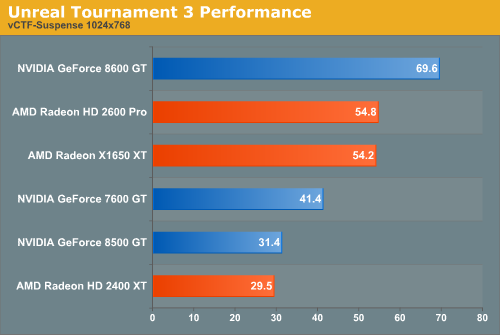
Looking at 1024x768, it is clear that if the final game is any more taxing than these flyby benchmarks we would want to run at a lower resolution with the 8500 GT or the 2400 XT. The 2600 Pro and the 8600 GT are a very clear step up from this category. The 7600 GT and the X1650 XT serve to fill in the gap between these price points.
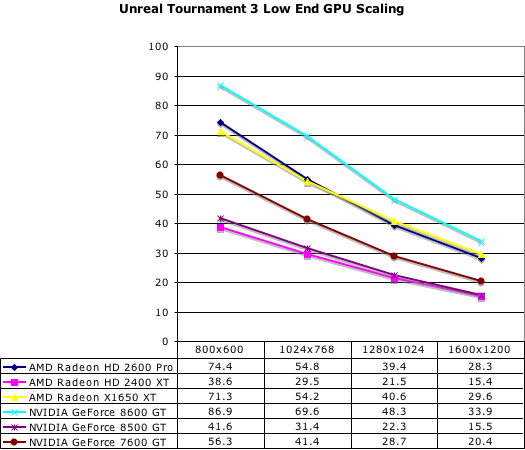
The 8500 GT and 2400 XT are well matched in terms of performance here. The 8600 GT leads the 2600 Pro (which essentially ties the x1650 xt in performance).
Mainstream GPU Performance
For gamers out there who play on a 1280x1024 panel, there is hardware to be had that doesn't cost a lot of money but will provide good performance at this very common resolution. The 2600 XT and 8600 GTS are the parts that we can really start getting interested in. Of course, making the jump up from this price point to the next leaves much to be desired: currently the $200 - $300 price segment is a bit lacking.
Again we've included older hardware for reference and we are also leaving the 8600 GT and the 2600 Pro. These parts really span the gap between the low end and mainstream price points. It's a shame we have so many offerings between $50 and $150 and so little up until we hit $300. But let's get to the benchmarks.
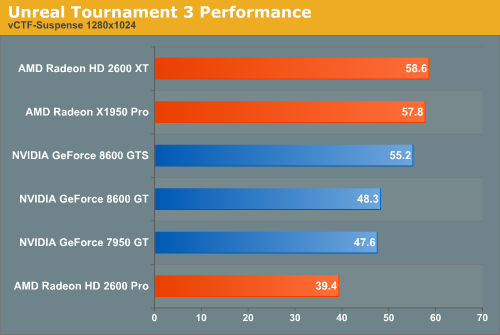
The 2600 XT, while less expensive than the 8600 GTS, manages to lead the pack here. Another win for AMD shows promise for their architecture in anticipation of the next gen titles looming in the distance. Does R6xx have some fight left in it? Will newer titles continue this trend, or is this a one time fluke that can be attributed to beta code? We really will have to wait and see on this one.
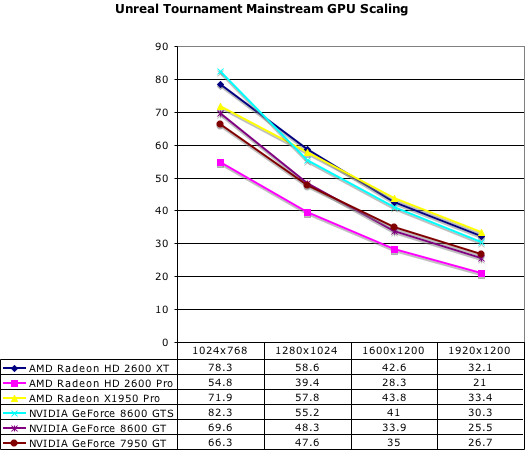
The X1950 Pro, HD 2600 XT, and 8600 GTS perform very similarly across most resolutions tested. The exception is 800x600 where the NVIDIA part leads the way. Of course, the card to pick is the 2600 XT, as it's cheaper than the 8600 GTS.
Bringing it all Together
With our look at the low end and mainstream markets wrapped up, it's time to take a look at how everything stacks up against everything else. Yes, it is difficult to really see what's going on here, but that's why we broke our GPU coverage down into three bite sized parts. We can pick a monitor size and look at how much graphics power we need to get the performance we want, or just see how much of an advantage one class of cards has over another. As we've already looked at 1024x768, 1280x1024, and 1920x1200 (in our previous article), here we will break out 1600x1200 and then look at scaling.
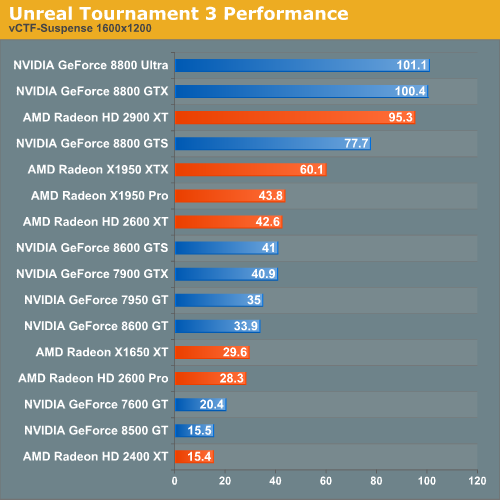
Looking at this graph, the AMD performance advantages are certainly clear. Bringing it all home is our scaling graph:
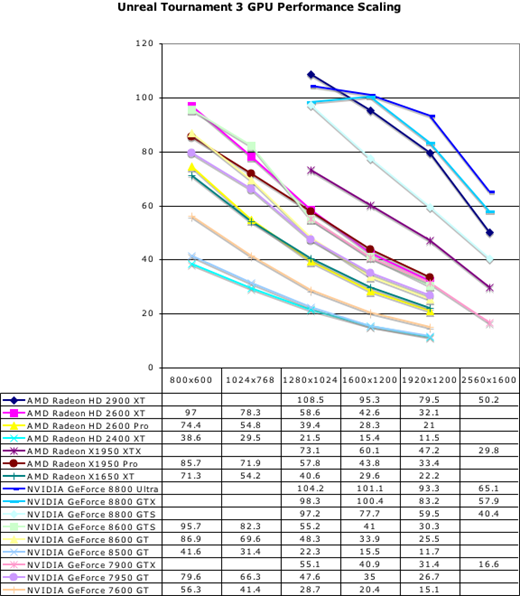
click to enlarge
There isn't much to be said here that hasn't already been covered. We do see more instances of cards scaling differently in this test than usual, and of course, there is the fact that AMD performance is quite good.
Final Words?
Well, these can't really be the final words on Unreal Tournament 3 performance, as running a flyby in the beta version of a demo for the game is more of a preview of what might come to pass. Epic still has time to refine their software, and AMD and (especially) NVIDIA will be working on prepping their drivers for the launch of the game as well.
While these tests did a good job of reproducing the numbers we saw when running around with FRAPS, a full multiplayer timedemo with character models, effects, and high resolution textures (which are not included in this beta demo) could really change what we see here. When we are able to get access to the demoplay feature of UT3, we will certainly revisit our tests with a much more brutal work load.
Hopefully this look at GPU performance under UT3 has been insightful, but our testing really leaves us with more questions than answers. Will AMD remain on top when the game launches? How will final game performance compare to this beta preview? Will the demo playback functionality change the playing field? Stay tuned, and we will answer these questions as soon as we can.







